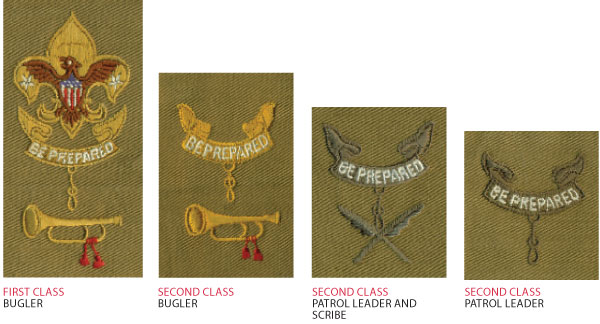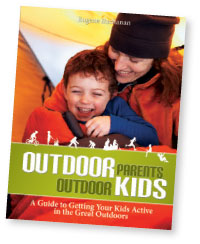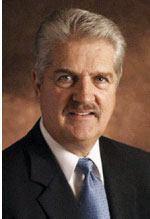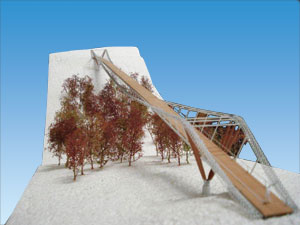
The Eagle Flies Again
 The first Eagle Scout, Arthur Eldred, and his Eagle Scout medal -- the first. |
Techies love to babble about 3G this and 3G that, but Tennessee Abbott goes them one better. The Seattle Scout from Troop 70 is 4G: a fourth-generation Eagle Scout who traces his lineage back to great-grandfather Arthur Eldred, who in 1912 became the first boy to earn the rank of Eagle Scout.
 Tennessee Abbott Photograph by Rosanne Olson |
When Tennessee joined Scouting in 2000, he wasn’t even aware of his great-grandfather’s honor; a few years later, his grandmother, Arthur Eldred’s daughter, told him about the family tradition. “She said it would mean a great deal to her if I stayed on track and became an Eagle,” he says.
Those words encouraged Tennessee during his middle-school years when many of his peers thought Scouting was “uncool.” He drifted away from troop meetings for a few months, but good friends talked him into sticking with it. When he returned, he made the decision to live up to the family legacy and go for Eagle.
For his Eagle project, he organized a successful blood drive for the Puget Sound Blood Center. His Court of Honor took place May 2.
Tennessee, who loves Alpine skiing, baseball, and soccer, entered the University of Washington this fall. He believes Scouting’s many lessons will serve him well along the way.
 Scouting's on the map
Scouting's on the map
BeAScout, a new Google-map application that will help prospective members and their parents find packs, troops, and crews in their communities, is now up and running on the Internet. Unit leaders can update their Google “pins”—the bubbles on Google maps—adding meeting times, locations, and other info. Another feature, “Ask Us! We Can Help!” allows people to e-mail questions to unit leaders. Get the whole download at beascout.scouting.org.
 Mother of Inventing
Mother of Inventing
Three years ago, Sam Estabrooks attended National Youth Leadership Training, where he learned that once upon a time in the early 20th century, Scouting offered an Invention merit badge. The badge had the dubious distinction of being the least-awarded badge in BSA history—only 10 Scouts earned it—and it was scrapped in 1915.
“So he came home with a wonderful problem for his mother to solve,” says Leigh Estabrooks. “He said, ‘Mom, you can fix this.’”
 Like any mom, Estabrooks said she’d give it a try—and, being the Invention Education Officer at the Lemelson-MIT Program in Cambridge, Mass., which aims to “inspire a new generation of inventors” through educational outreach and rewards, she was in a pretty good position to do just that.
Like any mom, Estabrooks said she’d give it a try—and, being the Invention Education Officer at the Lemelson-MIT Program in Cambridge, Mass., which aims to “inspire a new generation of inventors” through educational outreach and rewards, she was in a pretty good position to do just that.
Over the next year, Estabrooks worked with Scouting to develop the Inventing merit badge, which debuted this past June. Unlike the old badge, Scouts earning the Inventing badge won’t be required to apply for and receive a U.S. patent on an invention.
“That was maybe a little unrealistic,” she says. “We want them to focus on the process of inventing. We want them to have confidence that they can help others through inventing and be part of the solution to some of today’s big problems.”
For Inventing badge requirements, go to scouting.org/scoutsource/boyscouts/advancementandawards/meritbadges.aspx.
 The Chat Heard Round The World
The Chat Heard Round The World
On Oct. 16-17, the 53rd Annual Jamboree on the Air (JOTA) will take place. Each year during this worldwide Scouting and amateur radio event, more than 500,000 Scouts in 100 countries reach out to their peers via the airwaves.
Many districts and councils hold events that coincide with JOTA; often, amateur radio operators set up stations for the Scouts to use. It’s a great chance to start a friendship with someone who may live half a world away but shares the bonds of Scouting.
A related event, Jamboree on the Internet, occurs the same weekend. For detailed instructions on how to participate in these events, see the PDF files at scouting.org/scoutsource/international/program
enrichment/jota_joti.aspx.
 Backcountry Cuisine
Backcountry Cuisine
Hate to break it to those veteran Scouters out there, but the canned Beanie Weenees and charred hot dogs of camp-outs past are sooooo yesterday. Now the whole gang can get their backwoods gourmet on with Jetboil’s mobile cooking systems.
The 1.5-liter version is the Group Cooking System ($119.95). Just add a can of fuel, snap on the lid, and cook up scrambled eggs, rice, pan breads, and much more. Jetboil also offers the larger 2-liter Helios ($149.95), which boils water for pasta in less than three minutes, and the 1-liter Flash ($99.95), combining a burner and a cooking vessel that doubles as a drinking cup. Great for coffee, soup, or freeze-dried meals. See jetboil.com.
Double Duty
From 1915 to 1925, one-piece patches called combination-rank badges signified both a Scout’s rank and the position he held in his troop. Scouts who were patrol leaders, for example, sported a badge embroidered mostly in silver thread, while nonpatrol leaders wore one that was mostly done in gold thread. A scribe’s badge had crossed quills below the rank. A bugler’s had a bugle below the rank.
During those years, the highest rank was First Class. Life, Star, and Eagle were considered honors. Thus, an Eagle Scout would wear a First Class badge on his sleeve and display the Eagle medal on his pocket. If he was a patrol leader and also held another position, the badge would be silver with the position underneath also in silver.
This set contains the first Tenderfoot badge in cloth. Before this time, a Scout who had earned the Tenderfoot rank would get a pin. A patch was not available until 1921.
The rarest finds in the series are the Tenderfoot patrol leader, bugler, or scribe as that would indicate that the highest rank of the patrol leader was Tenderfoot and that he was also serving as the troop scribe or troop bugler.
In 1926, the BSA began providing separate patches for rank and positions.

Good Read
 Eugene Buchanan has a blunt, common-sense message for parents and youth leaders: If we don’t want kids to become nature-averse screen potatoes—and possibly obese and unhealthy—it’s not enough to bark, “Get up off the couch and go outside.” Instead, get up and go with the kids, introducing them to life-enhancing outdoor activities such as biking, snow sports, backpacking, fishing, and more.
Eugene Buchanan has a blunt, common-sense message for parents and youth leaders: If we don’t want kids to become nature-averse screen potatoes—and possibly obese and unhealthy—it’s not enough to bark, “Get up off the couch and go outside.” Instead, get up and go with the kids, introducing them to life-enhancing outdoor activities such as biking, snow sports, backpacking, fishing, and more.
To help with this quest, Buchanan, a veteran journalist, recently published Outdoor Parents, Outdoor Kids: A Guide to Getting Your Kids Active in the Great Outdoors. And when he calls it a “guide,” he’s being modest; “A-through-Z idiot-proof training-wheels guide” is more like it. The book is stuffed with hands-on, been-there advice that leaders can use and pass along to parents. It spells out in close detail how to help youngsters do just about everything, from choosing between fish scales and wax on their skis to the pros and cons of using PowerBait in fly-fishing.
For all his expertise, Buchanan writes like your pal, not your professor, candidly confessing what he’s learned from both blunders and triumphs. Get this book and get those kids outdoors. Heliconia Press, $19.95; helipress.com.
Spirit of Service
The National Eagle Scout Association has established the Glenn A. and Melinda W. Adams National Eagle Scout Service Project of the Year Award. It recognizes valuable service of an exceptional nature by a Scout to a religious institution, school, community, or other entity performed as part of the then-current requirements for earning the Eagle Scout Award.
One national award winner is chosen from among four regional award winners who are selected from local council winners. The recipient of the national award will receive a plaque, a silver Eagle knot device, and a cash award of $2,500 for the Scout’s future educational purposes or for the Scout to attend a national or international Scouting event or facility. The national award winner’s local council also will receive a $2,500 award.
The first award went to Alex Griffith of Jarrettsville, Md., at the BSA’s National Annual Meeting in May. The Scout, from Troop 809 in the Baltimore Area Council, raised nearly $63,000 and enlisted the aid of 634 volunteers from 23 states to build a playground in Krasnoyarsk, Russia.
For information on how to submit projects and about the awards at other levels, go to nesa.org.
A Bridge to the Future
One of the most-important projects in recent Scouting history, the BSA’s new high-adventure base in West Virginia, has moved a step closer to reality.
 J. Brett Harvey |
That’s thanks to a generous gift from CONSOL Energy, which recently donated $15 million over five years to build the CONSOL Energy Bridge at The Summit Bechtel Family National Scout Reserve. The bridge, more than 700 feet long and rising 200 feet above a giant ravine, will connect the main activity area to the eastern half of the property.
 A model for the CONSOL Energy Bridge. |
“This incredibly generous gift, both figuratively and literally, will help carry us from our first century of Scouting into the next 100 years,” says Chief Scout Executive Bob Mazzuca. “We can all look forward to the day when Scouts will cross this new span to take part in bold new programs that will ultimately transform them from boys into men.”
CONSOL’s gift follows last year’s $50 million contribution from the Stephen D. Bechtel Jr. family.
J. Brett Harvey, president and CEO of CONSOL, has a long history with Scouting as a local volunteer and member of the BSA’s National Executive Board, the BSA National Foundation, and the 2010 jamboree committee. He is serving as chairman of Arrow WV Inc., the BSA subsidiary charged with developing the new high-adventure base that will open for the 2013 jamboree.
New Policies on Youth Protection
The BSA has announced important changes to its Youth Protection policies. Effective June 1, 2010, Youth Protection training is now required for all BSA registered volunteers regardless of position.
New leaders must submit a certificate showing the training has been completed along with their application before volunteer service with youth begins.
Youth Protection training must be taken every two years. If a volunteer’s training record is not current at the time of recharter, the volunteer will not be reregistered.
For detailed information and answers to questions about these changes, visit scouting.org/youthprotection.
Venturing Changes
The National Executive Board recently changed the eligibility requirements for Venturing to ensure consistency among Venturing, high-adventure bases, and other core programs. Effective May 1, 2010, the minimum age requirements became:
- 14 years of age, or
- 13 years of age and completion of the eighth grade.
Venturers may remain registered as youth members until their 21st birthday. For more information, see the questions and answers at scouting.org/venturing.